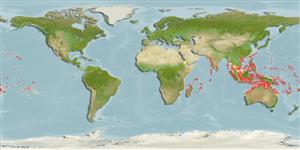>
Anguilliformes (Eels and morays) >
Muraenidae (Moray eels) > Muraeninae
Etymology: Gymnothorax: Greek, gymnos = naked + Greek, thorax, -akos = breast (Ref. 45335).
More on author: Schultz.
Environment: milieu / climate zone / Tiefenbereich / distribution range
Ökologie
seewasser riff-verbunden; tiefenbereich 1 - 58 m (Ref. 58302). Tropical; 28°N - 25°S
Indo-Pacific: East Africa to the Marquesas and Mangaréva, north to the Hawaiian Islands, south to the Australs.
Size / Gewicht / Alter
Geschlechtsreife: Lm ? range ? - ? cm
Max length : 30.0 cm TL Männchen/unbestimmt; (Ref. 90102)
Rückenflossenstacheln (insgesamt) : 0; Rückenflossenweichstrahlen (insgesamt) : 0; Afterflossenstacheln: 0; Afterflossenweichstrahlen: 0; Wirbelzahl: 132 - 149. Golden in color with dark spot around gill opening (Ref. 3257). May also be variable from brown to bright golden yellow and eye with deep blue color (Ref. 48635). Has short conical teeth like those of G. fuscomaculatus and G. marshallensis (Ref. 37816). Further characterized by body depth at gill opening 13-20 in TL; origin of dorsal fin about midway between gill opening and corner of mouth; anus anterior to middle of body; small and stout teeth; without canines; single row of teeth at front of upper jaw; with 1-2 median teeth; teeth in two rows on each side of upper jaw; longer and more slender inner row teeth; larger teeth at front of lower jaw (Ref. 90102).
Body shape (shape guide): eel-like.
Benthic (Ref. 58302). Lives in holes and crevices of seaward reefs from the surge zone to over 26 m. Solitary and secretive in reef crevices; seldom seen (Ref 90102).
Life cycle and mating behavior
Geschlechtsreife | Fortpflanzung | Ablaichen | Eier | Fecundity | Larven
Chen, H.-M., K.-T. Shao and C.T. Chen, 1994. A review of the muraenid eels (Family Muraenidae) from Taiwan with descriptions of twelve new records. Zool. Stud. 33(1):44-64. (Ref. 6934)
IUCN Rote Liste Status (Ref. 130435: Version 2024-2)
Bedrohung für Menschen
Harmless
Nutzung durch Menschen
Fischereien: weniger kommerziell
Tools
Zusatzinformationen
Download XML
Internet Quellen
Estimates based on models
Preferred temperature (Ref.
123201): 25.4 - 28.9, mean 27.7 °C (based on 664 cells).
Phylogenetic diversity index (Ref.
82804): PD
50 = 0.5000 [Uniqueness, from 0.5 = low to 2.0 = high].
Bayesian length-weight: a=0.00048 (0.00025 - 0.00091), b=3.28 (3.12 - 3.44), in cm total length, based on LWR estimates for this Genus-body shape (Ref.
93245).
Trophic level (Ref.
69278): 3.8 ±0.6 se; based on size and trophs of closest relatives
Widerstandsfähigkeit (Ref.
120179): mittel, Verdopplung der Population dauert 1,4 - 4,4 Jahre. (Preliminary K or Fecundity.).
Fishing Vulnerability (Ref.
59153): Low vulnerability (20 of 100).
🛈
Nutrients (Ref.
124155): Calcium = 57.9 [32.4, 117.6] mg/100g; Iron = 0.562 [0.339, 1.118] mg/100g; Protein = 18.7 [16.4, 21.3] %; Omega3 = 0.133 [0.060, 0.394] g/100g; Selenium = 34 [18, 71] μg/100g; VitaminA = 99.8 [29.9, 309.0] μg/100g; Zinc = 1.13 [0.80, 1.59] mg/100g (wet weight);
